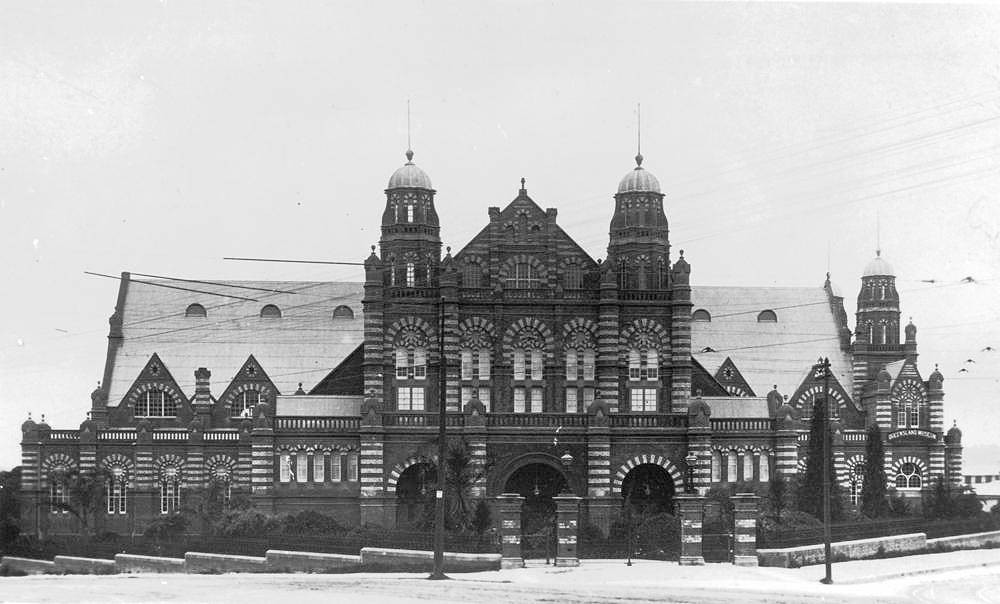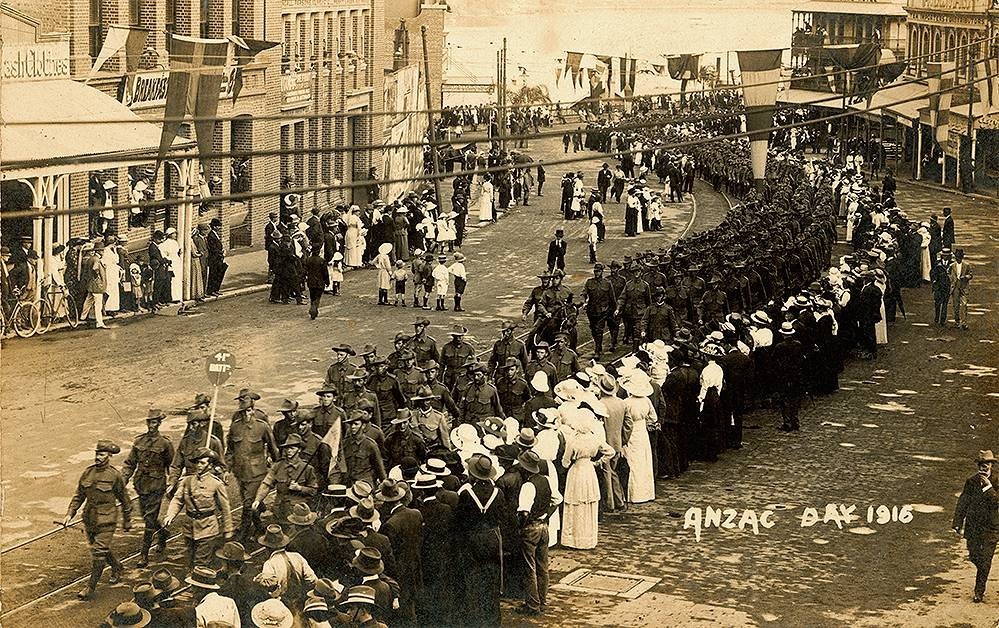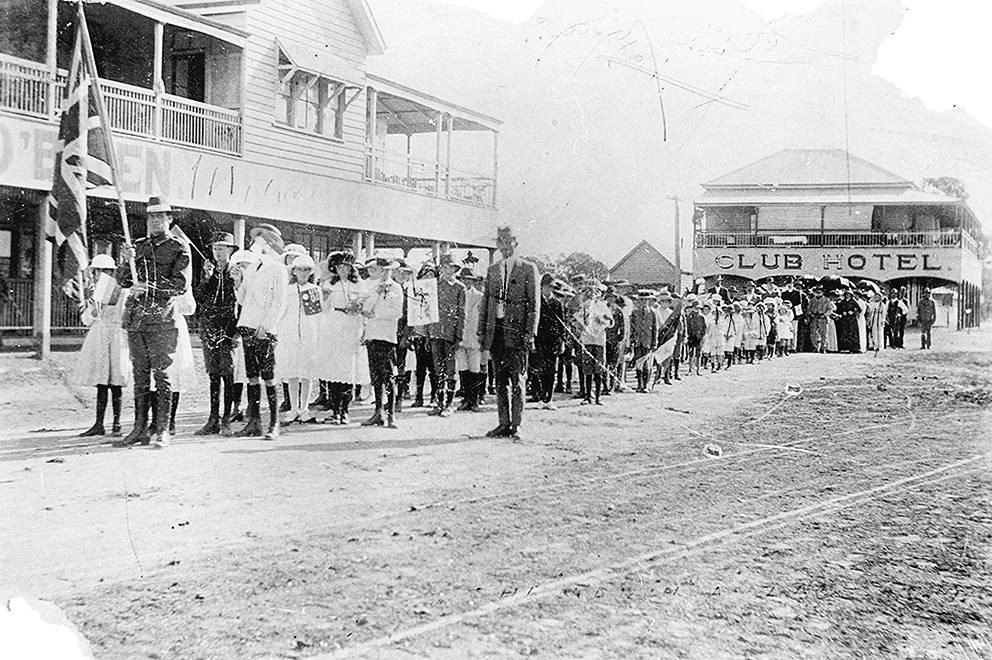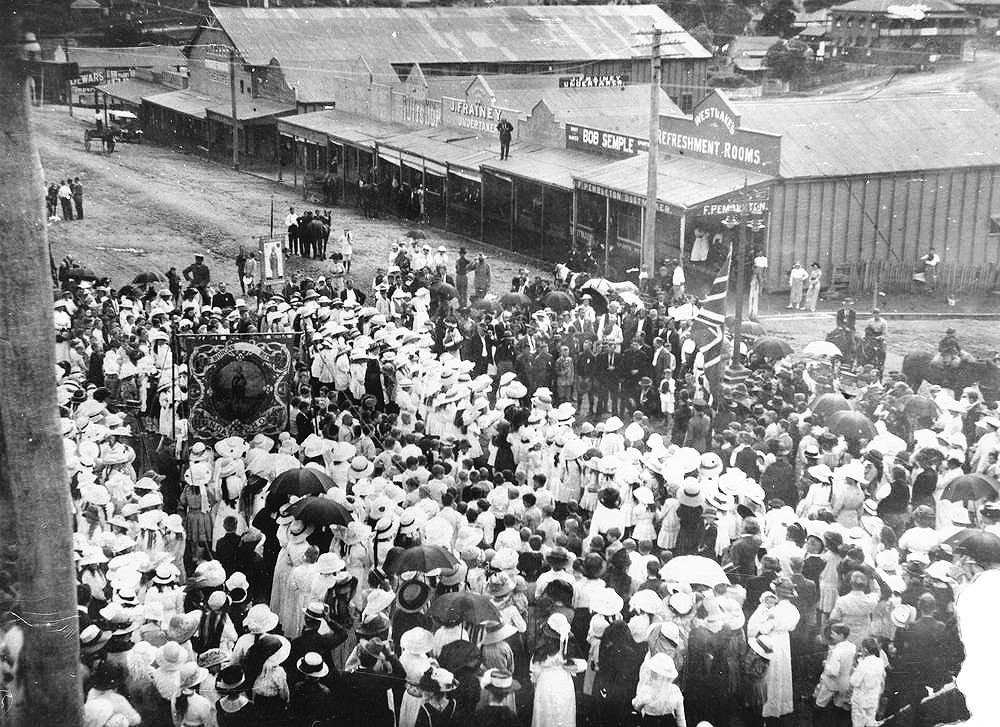Beginnings
On the 25 April 1916, one year to the day that Australians troops splashed ashore at the Gallipoli Peninsula, 6434 servicemen paraded through the streets of Brisbane before 50,000 onlookers.
This was the first instance of what would soon become an annual national ritual of observance - Anzac Day.
The origin of Anzac Day is a uniquely Queensland story. Following the suggestion from Brisbane land agent T.A. Ryan to chairman of the State Recruiting Committee, Colonel A.J. Thynne , a committee was formed in February 1916 to explore ways to publicly commemorate the almost 8 000 soldiers who had died in the failed campaign.

The committee
The Anzac Day Commemoration Committee of Queensland (ADCCQ) comprised leading establishment figures, including the Premier T.J. Ryan, The Minister for Education, The Mayor of Brisbane.
The appointed Secretary of the Committee was Canon David John Garland, an active member of the Queensland Recruiting Committee became one of the key driving forces behind the formal adoption of Anzac Day commemoration ceremonies nationwide.
Significant documents
![Anzac Day 25th April, 1916 [programme] A. J. Cumming, Government Printer Brisbane, Qld. : A. J. Cumming, Government Printer,1916 John Oxley Library, SLQ RBJ 940.426 ANZ](/sites/default/files/styles/slq_standard/public/SigdocsV-div-Programme-large.jpg?itok=HHg56n8G)
The first processions

There was an underlying need to reassure the public that Australian losses had not been in vain, despite the failure of the Gallipoli campaign.
The committee was also concerned that there should be no sense of triumph or jubilation, and were careful to try and divorce the first Anzac Day from the many fund-raising, recruitment and other patriotic activities then being undertaken across the state.
Premier Ryan urged the other Australian states to enact a similar parade, and soon the date became a national day of reflection. By then, Australian troops were fighting and dying in France and the Middle East, and the losses incurred on both these fronts soon dwarfed the original toll at Gallipoli.

Digital Stories
Origins of Anzac Day in Queensland
Anzac Day is our national day of remembrance, an opportunity to commemorate those Australians and New Zealanders who have served and died in conflict. This digital story examines the key part which Queensland played in the development of this national day. The Queensland Anzac Day Commemoration Committee was formed in early 1916, and its deliberations instituted elements such as the parade of troops, the minute's silence, and the Last Post, which are still observed today. In particular, the efforts of honorary secretary Canon David John Garland, ensured that Anzac Day remained a solemn, community commemoration of wartime sacrifice, rather than a celebration.
Queensland chaplains during the First World War
An examination of the role and experiences of Queensland chaplains during the First World War, with particular reference to three Anglican chaplains – The Reverend William Maitland Woods, The Reverend George Green and Canon David John Garland, whose papers are held in the John Oxley Library, State Library of Queensland. Chaplains were responsible for the spiritual welfare of the soldiers, and alongside the more gruesome task of burying the dead, they provided important pastoral care and emotional support to their comrades.
Reflection
While the original intention of the Anzac Day committee was to honour those who fell in Australia’s first major military engagement of World War One, subsequent events soon broadened its scope and meaning, eventually culminating in the current Anzac Day commemorations with which most Queenslanders are familiar.

Further resources
One Search Catalogue
- Anzac Day procession through the streets of Brisbane, 1916
- A school commemoration of Anzac Day (Page 21 of the Queensland Pictorial, suplement to The Queenslander, 29 April, 1916
- Page 24 of the Queenslander Pictorial, supplement to The Queenslander, 6 May, 1916
- Page 25 of the Queenslander Pictorial, supplement to The Queenslander, 6 May, 1916
- Official recruiting team during a recruiting rally, ca. 1915
- Religious leaders at Anzac Day ceremony, Bulimba, Queensland, 1926
- ANZAC Day, first anniversary : Fourth Australian Division, Serapeum Egypt : April 25th 1916 : program
- Queensland Recruiting Committee Records 1914-1918
- ANZAC Day Commemoration Committee Records 1916-1974
Blog
- Queensland’s First Anzac Day
- Queensland Recruiting Committee records digitised@SLQ
- Thomas Augustine Ryan – instigator of Anzac Day
- Canon David Garland - Architect of Anzac Day
- Digitised@SLQ: letters of army chaplain David John Garland
- The Reverend William Maitland Woods - army chaplain A.I.F.
External links
- Maitland Woods Papers 1915-1916
- Entry for David John Garland in Australian Dictionary of Biography
- Entry for William Maitland Woods in Australian Dictionary of Biography
- Anzac Day in Queensland - historians Mark Cryle and Professor Martin Crotty discuss the origins of Anzac Day in Queensland
- Moses, Dr. John. Anzac Day as Australia’s All Souls’ Day: Canon David John Garland’s Vision for Commemoration of the Fallen
- Moses, Dr. John. Canon David John Garland: Architect of Anzac Day, Empire Patriot and Caring Chaplain
- Canon Garland Memorial Society
This content first appeared on the Q ANZAC 100: Memories for a New Generation website. A five-year state wide legacy initiative providing Queenslanders with opportunities to learn and contribute to bringing our history to life and a renewed WWI and Anzac legacy for future generations.
This project was developed by State Library of Queensland and supported by the Queensland Government.
Comments
Your email address will not be published.
We welcome relevant, respectful comments.